MXA RACE TEST: THE REAL TEST OF THE 2022 HONDA CRF450
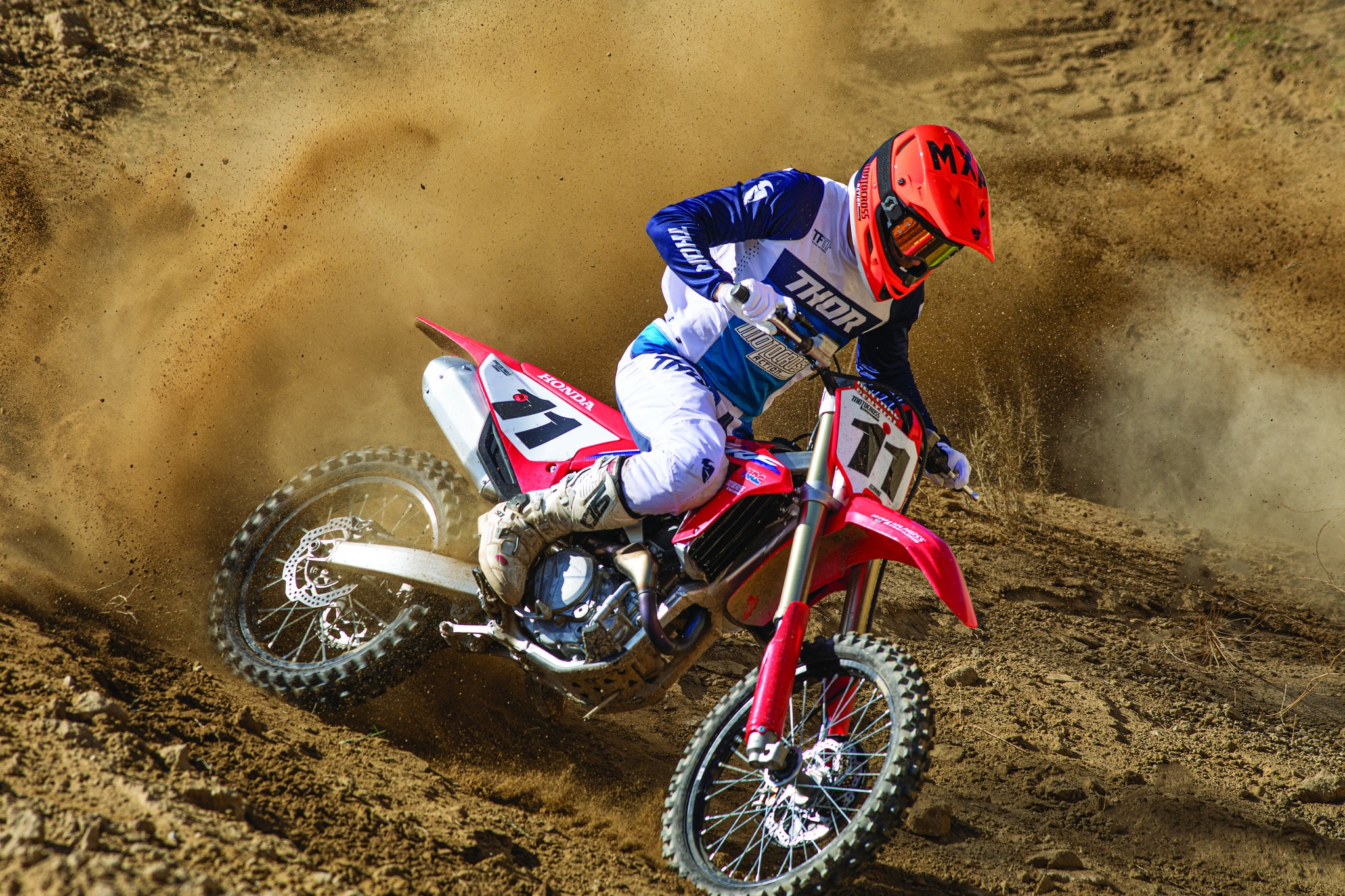 THE GEAR: Jersey: Thor MX Pulse, Pants: Thor MX Pulse, Helmet: Thor MX Reflex, Goggles: Scott Fury, Boots: Sidi Crossfire 3SR.
THE GEAR: Jersey: Thor MX Pulse, Pants: Thor MX Pulse, Helmet: Thor MX Reflex, Goggles: Scott Fury, Boots: Sidi Crossfire 3SR.
Q: FIRST AND FOREMOST, IS THE 2022 CRF450 BETTER THAN THE 2021 CRF450?
A: Yes, but there are only two major changes, and one of them was a mid-season update to the 2021’s ECU mapping to fix the 2021 Honda’s erratic mapping at low rpm and in off-throttle situations. To cure the 2021 ECU glitch, Honda released, albeit very late, a service bulletin telling 2021 CRF450 owners to take their bikes to their local Honda dealers to have the black box flashed with a much-improved map; however, by the time Honda released the bulletin, most serious racers had already paid hop-up shops to re-map their bikes.
The second update to the 2022 CRF450 was to have the 49mm Showa forks re-valved with increased compression damping in lieu of a fork spring change. The goal was to help the CRF450 ride higher in its stroke and slow down the rate of collapse. As for the shock, it got the same damping changes, also in lieu of a spring rate change.
Both the mapping glitch and the suspension faux pas should have been caught somewhere between the 2021 pre-pro phase and production phase of final development, but they weren’t. According to sources at Honda, there was little or no testing done by Honda’s U.S. test riders. We believe our sources, because when we first tested the 2021 CRF450, it was blatantly obvious that it was an unfinished project. We rode it, raced it, lived with it and tried to fix it. The two flaws weren’t deal breakers, but they were sins of omission that raised buyer’s aggravation levels and cost of ownership.
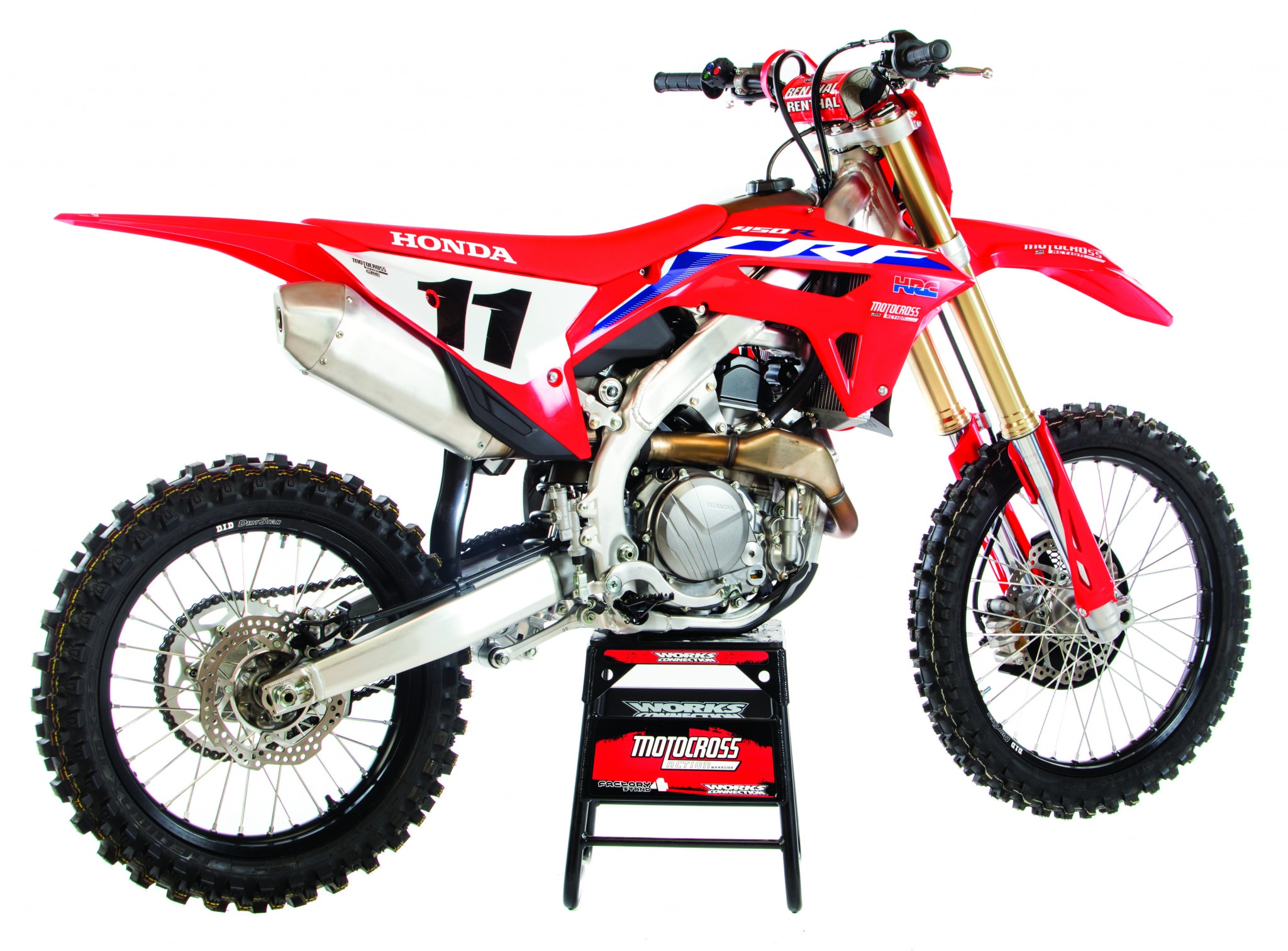
The 2022 Honda CRF450 is a beautiful bike. It is sleek, slim and well-proportioned. Once on board, everything feels like it’s in the right place.
Q: WHAT EXACTLY ARE “FIRST-YEAR” MODEL MISTAKES & HOW DO THEY APPLY TO THE SECOND YEAR?
A: From an historical perspective, Honda’s 2021 CRF450 gaffes are fairly typical “first-year” model mistakes. And Honda has made a few of them trying to patch up the boo-boos in model years two or three. Need examples?
2009 CRF450. In 2009, Honda experimented with geometry that was different from any other motocross bike ever made. It was best known as the “cab-forward design.” It was not popular, and unfortunately it stayed terrible for the complete four-year production cycle (2009–2012).
2013 CRF450. Honda got rid of the ill-conceived cab-forward geometry in 2013 but instituted its infamous “slower is better” philosophy, which gave up as much as 5 horsepower to the competition. Additionally, they jumped on the ill-fated air fork bandwagon with the consumer-mystifying Kayaba PSF air forks and kept them on the CRF450 for four distressing model years (2013–2016).
2017 CRF450. Honda tried to retreat from eight years of miscalculations by dropping the “slower is better” philosophy and the PSF air forks in 2017. Most significant, Honda came to the realization that it could no longer ignore first-year mistakes for four years. Honda tried to fix the flaws of the 2017 CRF450 immediately and spent three years adding electric starting, better mapping, revised shock linkages, stronger brakes and, most obviously, more horsepower (culminating in the 60-horsepower 2019 version). All in all, this four-year cycle (2017–2020) ended up producing the best Honda CRF450s since 2008.
2021 CRF450. Which gets us to the current generation of CRF450 models. In comparison to past first-year miscues, the mapping and suspension issues of 2021 are blips on Honda’s radar screen, because the 2021 CRF450 came with significant upgrades. The 2021 CRF450 dropped 5 pounds to get down to 233 pounds, got rid of the ridiculously stupid twin pipes, narrowed the bodywork by 70mm, enlarged the airbox (albeit upside down), broadened the powerband (by reducing horsepower, but not to the slower-is-better levels) and installed a six-spring, eight-plate, no-judder-spring, hydraulically activated clutch. These were giant leaps for Honda-kind after 12 years of miscalculations.
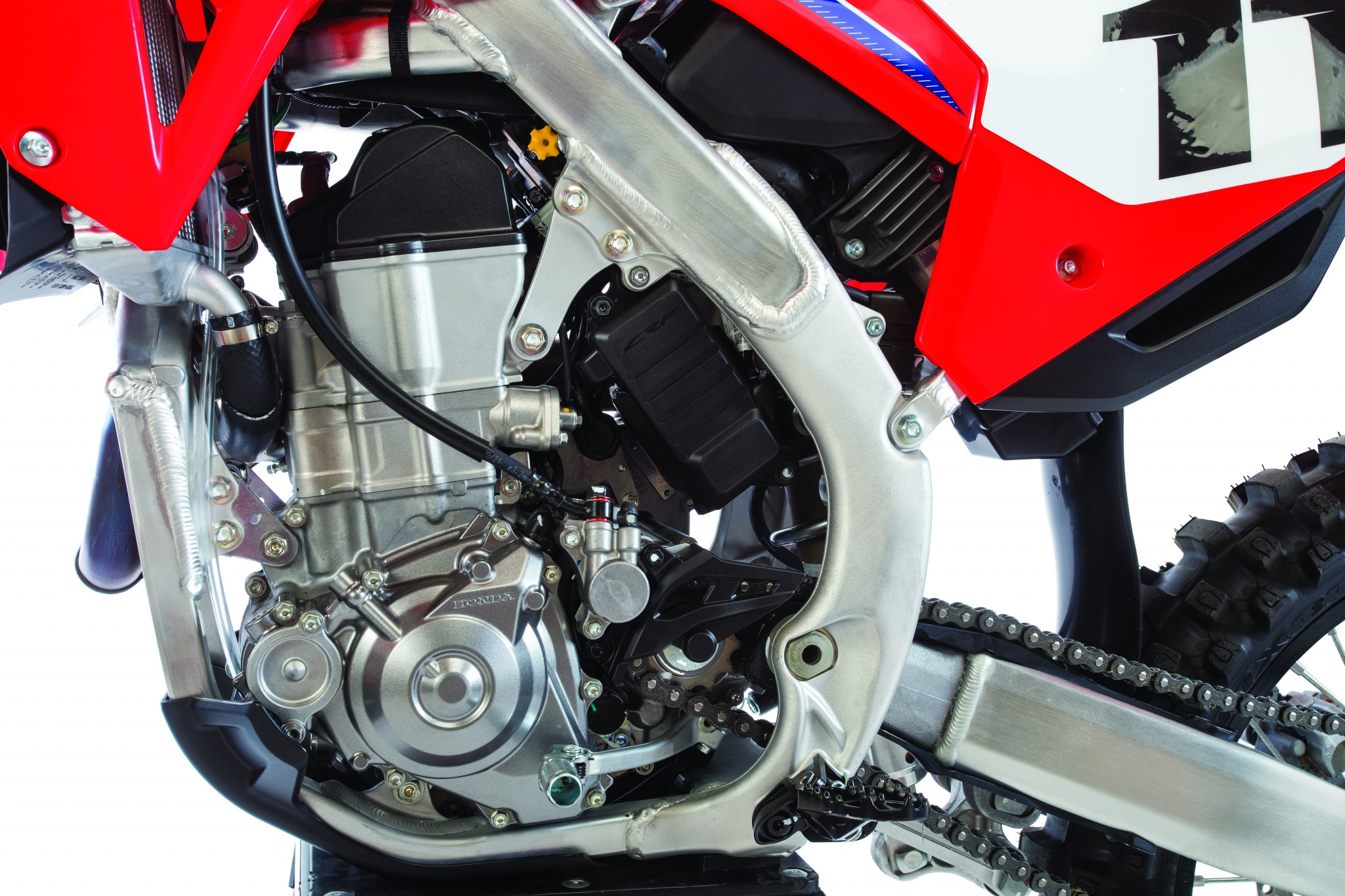 The 2022 Honda CRF450 engine is identical to the 2021 model, but with last year’s mid-season map update was made permanent for 2022.
The 2022 Honda CRF450 engine is identical to the 2021 model, but with last year’s mid-season map update was made permanent for 2022.
Q: HOW FAST IS THE 2022 HONDA CRF450?
A: We love this engine. Unlike the mellowed-out powerplants of 2009 through 2016, or the hyper engines of the last couple years, the 2022 engine is more refined and less aggressive. It has a linear powerband that builds its thrust steadily from way down low to way up high. There is no need to floor it, punch it or hammer it; just let it pull. The old “slower is better” engine had CRF450 riders gasping to stay with their competition. The brutal 60-horse engines of 2019-2020 had CRF450 racers hanging on as jolts of power rocked them back in the saddle. The 2021–2022 engine is much more usable by slow riders and fast riders alike.
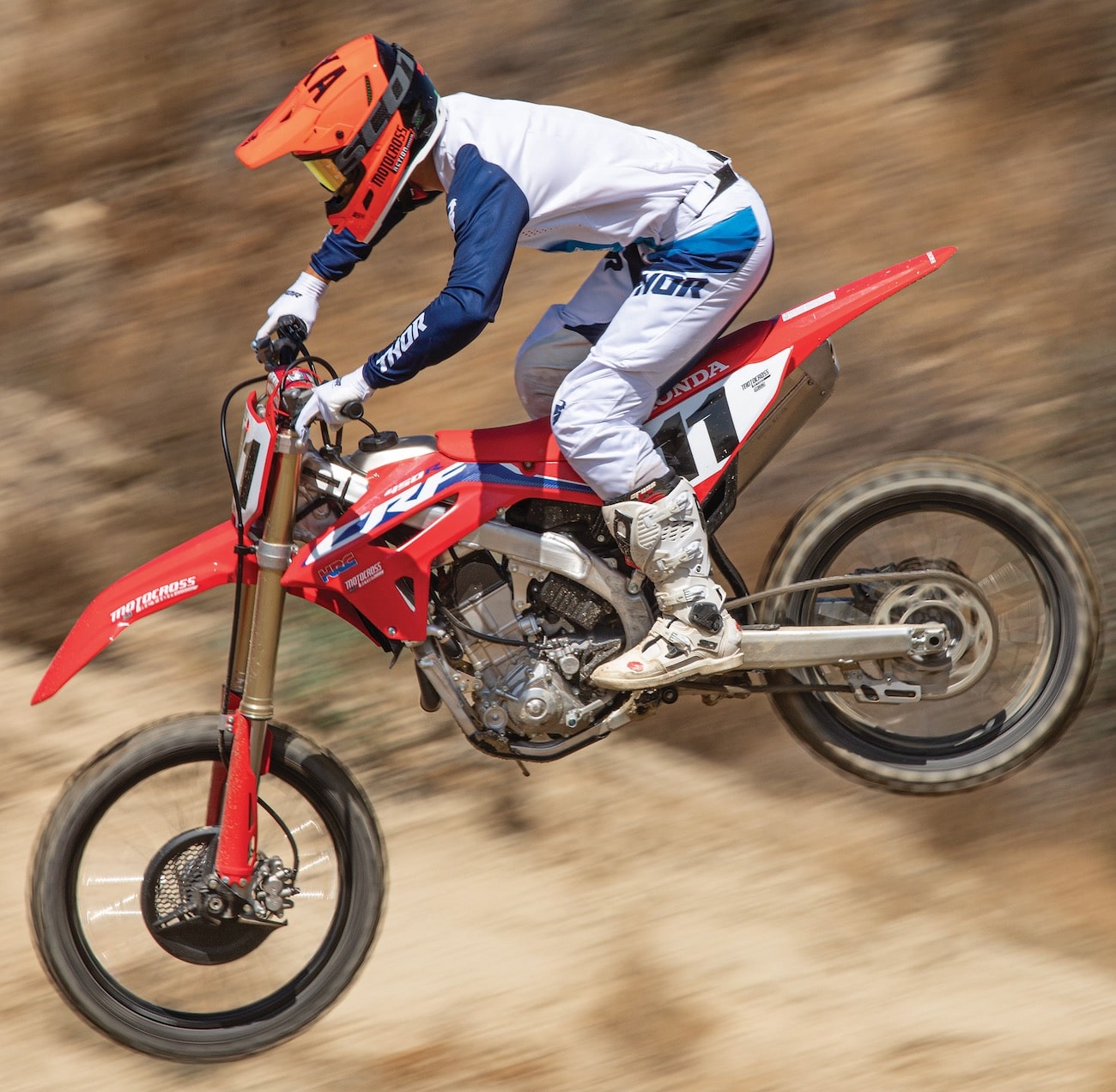 The 2022 Honda Showa forks are harsh as harsh can be in the last four inches of travel. Yes, you can fix them, but it will cost you.
The 2022 Honda Showa forks are harsh as harsh can be in the last four inches of travel. Yes, you can fix them, but it will cost you.
Q: HOW DOES THE ALL-NEW 2022 HONDA SUSPENSION WORK?
A: It isn’t great. Last year the 2021 CRF450 was belittled as being “a pure-bred motocross bike with play-rider suspension.” That stung! So, Honda asked Showa to make the 2022 forks stiffer, in part to end complaints but also in an effort to get the forks to ride higher in their stroke to stop the “stink bug” references. A stink bug is a large insect that when threatened goes into a nose-down/tail-up stance. The term is often used to define bikes that are low in the front and high in the rear. Last year, Honda lengthened the forks to try to fix the CRF450’s nose-down stance. It didn’t help much, so this year they drafted increased damping to help flatten the chassis and eradicate the stink bug.
Even though Honda shares the same basic Showa fork with Kawasaki and Suzuki, none of the three are as good as Yamaha’s SSS forks or WP’s XACT air forks in performance. And, when factory engineers are told that their forks are too soft; they stiffen them up. In the case of the 2022 CRF450, the 2022 forks are better, but only from their initial movement to the mid-stroke. If Showa could have kept the plush feel all the way to the last inch, these would have been great forks; however, after the mid-stroke, the compression damping ramps up too quickly. The forks get stiff and harsh. Average-speed riders can’t always get full travel, and fast Pros, who break through the crust, don’t like the jarring feel.
Are these forks better than the 2021 Showa forks? Yes and no. The 2022 forks ride higher in the stroke, while the 2021 forks dropped down under a load. The 2022 forks have more damping control until about two-thirds of the way through their travel, but the softer and plusher 2021 forks are better for slow, light and Vet riders. Overall, serious riders had to fix the softness of the 2021 CRF450 forks while 2022 CRF450 riders have to mitigate the sudden ramp-up of the compression damping at the end of the stroke.
The Showa shock is very sag sensitive, click sensitive and balance sensitive. The hardest task facing MXA test riders was getting the suspension balanced. One end always overpowers the other. Worse yet, if you fixed the troubled end, it then overpowered the other end. It was a never-ending dance.
 The air filter is mounted upside down, while the throttle body’s air intake goes up and over the shock tower. This is a great design, but why does the air filter get so dirty so quickly?
The air filter is mounted upside down, while the throttle body’s air intake goes up and over the shock tower. This is a great design, but why does the air filter get so dirty so quickly?
Q: HOW SHOULD YOU SET UP THE CRF450 SUSPENSION?
A: Our advice may seem strange, but forget all you know about modern bike setup. In our experience, the tried-and-true setup specs just make things worse on the CRF450. Take race sag as an example. Modern wisdom is to run the rear suspension with 105mm of race sag. This is great on a KTM, Kawasaki, Suzuki or Yamaha, but it aggravates the CRF450’s frame geometry. By dropping the sag to 105mm, you slacken the CRF’s head angle, which takes pressure off the forks and shifts the balance point rearward. It will still turn in perfectly, but it will be loose on corner exit. It is smarter to run the race sag closer to 100mm, which raises the rear of the bike, steepens the head angle and sharpens turn-in. We agree that this could lead to oversteer, but a touch of oversteer is what the 2022 Honda needs to keep the front wheel tracking as the corner unfolds and front tire’s bite is lessened. In short, the effectiveness of the front forks is dependent on how you set up the shock.
As for the shock, it is a wallower. The culprit in this scenario is that the rear shock spring is too light, which makes the shock busy in the bumps. And instead of taking a set, the rear shock feels stagey, but not in the traditional way of dropping, stopping and dropping again. The 2022 Honda CRF450 shock never ever takes a set; it just keeps searching for equilibrium. The cure, if you have the speed or weight to support it, is to switch to the next-stiffest shock spring. In conjunction with the spring change, we stick with the stock low-speed compression setting, lighten the high-speed compression by 1/8th of a turn and set the rebound a click or two slower. On the front end, we slide the forks up in the clamps until they are flush with the fork clamps, increase the compression damping, and turn the rebound damping out.
Most MXA test riders went to the next stiffest shock spring to help calm the rear down. If this didn’t get the shock to stop feeling stagey in the bumps, we increased the rebound and decreased the high-speed compression. For fast or heavy riders, we switched to a 56 N/mm spring. The CRF450 rear shock works well at low speeds and in bumps that don’t stress it very much, but once you push the shock harder, it will G-out in jumps and whoops.
We know that this suspension setup is rife with contradictions, but then so is the 2022 Honda CRF450
 Last year’s 49mm Showa coil-spring forks lacked mid-stroke compression damping. This year’s Showa forks have too much damping at the end of the stroke—largely because they replaced all the thin shims in the base valves with shims from a Freightliner truck.
Last year’s 49mm Showa coil-spring forks lacked mid-stroke compression damping. This year’s Showa forks have too much damping at the end of the stroke—largely because they replaced all the thin shims in the base valves with shims from a Freightliner truck.
Q: WHAT IS THE 80-PERCENT SOLUTION TO 2022 HONDA CRF450 HANDLING
A: The 2022 CRF450’s best handling trait is at turn-in. Every MXA test rider marveled at how effortless it was at attacking tight inside lines. In the corners, the CRF450 had, dare we say it, “Suzuki-like accuracy.” Of course, just as on the Suzuki RM-Z450, the price you pay for razor-sharp turning is head shake at speed.
There was a corollary side effect to Honda’s incredible turn-in prowess. For as great as it was at turn-in, it felt loose on corner exit. Frame geometries that favor turning prowess over stability tend to step out when the side thrust of tight cornering is released. And one handling trait that has always been a part of Honda’s DNA is head shake. In conjunction with the head shake is that the rougher the track and faster the rider, the more the frame displays a mind of its own. At full-tilt over rough ground, the Honda would suddenly twitch enough to scare even steely eyed National Pros. Slower riders get in less trouble than Pro riders.
In MXA’s opinion, Honda’s absolute worst handling trait exhibits itself when the CRF450 is pushed by a rider above 80 percent of its capabilities. If you stay below 80 percent, the Honda chassis is gentlemanly in its manners. It is only at speed that the combination of an overly rigid frame, unequal suspension settings and the frame’s harmonic imbalance make the Honda difficult to ride. MXA test riders often came in from a moto and said, “I was wide open down the back straight when the CRF450 decided to snap in the wrong direction.” When questioned closer, the test riders would rave about how fun, fast and flickable the 2022 CRF450 was in one sentence and, in the next sentence, complain about it being loose on exit, prone to breaking the rear loose on acceleration and being twitchy at full speed.
We know riders who make the 2022 look like a magic bike, but they tend to be smooth, precise and talented riders who choose to let the CRF450 flow by depending on consistent speed to make the bike work. A classic example is Ken Roczen’s smooth and successful style, while his go-for-broke Honda teammates often end up on the ground, without explanation.

Q: WHAT DID WE HATE?
A: The hate list:
(1) Radiators. It boils water like a steam iron. We check the water after every long moto. Switch to a high-pressure radiator cap.
(2) Forks. The forks need lots of help. Depending on your weight and speed, it might be stiffer forks, springs, an oil height change, or a total re-valve. But mostly it is a revalve of the Showa fork’s base valve shims.
(3) Seat foam. When the seat gets broken in, the foam breaks down, soon followed by your pelvic bones breaking down.
(4) Shock. We think the shock works better with a stiffer shock spring. Of course, the opposite is true for lighter riders.
(5) Electronics. An incredible number of Honda riders have no idea how the map lights work, which light is which for traction control, or how to engage the launch control map. There are three maps available through the handlebar-mounted multi-switch. They are stock (one flash of the blue light), mellow (two flashes) and aggressive (three flashes). Additionally, there are three levels of traction control and three levels of launch control.
(6) Balance. We got dizzy trying to find a good fore and aft balance. Any change to the front ruins the rear and vice versa.
 Last year’s bad mapping is fixed, but the questionable fork damping, hinge in the middle of the chassis and wallowy shock detract from the 2022 CRF450’s performance.
Last year’s bad mapping is fixed, but the questionable fork damping, hinge in the middle of the chassis and wallowy shock detract from the 2022 CRF450’s performance.
Q: WHAT DID WE LIKE?
A: The like list:
(1) Horsepower. Two years ago, we were impressed by the CRF450’s quantitative horsepower; for 2022, we are impressed by its qualitative horsepower. More power is not the answer for a rigid, aluminum-framed motocross bike; it needs the right kind of power.
(2) Ergos. No bike is as well laid out as a CRF450.
(3) Electric starting. Best of all, we don’t have to pull the clutch in to get the starter button to engage anymore.
(4) Maps. We like adjustable maps, but unlike the 2022 CRF250, which has big differences between its maps, on the CRF450, maps are like splitting hairs. We preferred the stock map most of the time.
(5) Gearing. The stock 13/49 gearing is in the ballpark, but we found ourselves wanting to go down to first gear in some corners and having trouble pulling third under a load. Our cure was to go from the stock 49 teeth to 50 teeth to eliminate first gear as an option and enhance third gear to engage it quicker.
(6) Airbox. Even though the airbox looks like it has less air volume, the air volume is jumbo-sized on the other side of the filter.
(7) Single pipe. We have lived with Honda twin pipes since 2006. It took Honda’s engineers 15 years to realize that it was a bad idea. We told them that back in 2006.
(8) Clutch. Honda’s clutch has been weak since 2009, and, to make matters worse, it came with the less-than-stellar judder spring system. Thankfully, the 2022 clutch gets six springs, eight plates, no judder spring, hydraulic actuation and a 27-percent-larger capacity. But, it’s not bulletproof.
(9) Brakes. The brakes had great modulation and worked well.
Q: WHAT DO WE REALLY THINK?
A: Honda typically releases an updated CRF450 every four model years. The 2021 CRF450 was the first of this generation of CRF450s, and last year MXA advised CRF450 buyers to “Never buy a first-year model.” Now, it is 2022; we are in “year two,” and we aren’t asking you to wait another two-years. Instead, we are hoping for a new generation first-year model in 2023.
 When raced with a smooth flowing style, à la Ken Roczen, the CRF450 can do no wrong. However, ride it like a hammerhead and it will hammer you.
When raced with a smooth flowing style, à la Ken Roczen, the CRF450 can do no wrong. However, ride it like a hammerhead and it will hammer you.
MXA’S 2022 HONDA CRF450 SETUP SPECS
This is how we set up our 2022 Honda CRF450 for racing. We offer it as a guide to help you find your own sweet spot.
SHOWA COIL SPRING FORK SETTINGS
Everyone asked Honda for stiffer forks in 2022, but we meant stiffer overall all, not stiffer in one spot. For hardcore racing, these are MXA’s recommended 2022 CRF450 fork settings (stock settings are in parentheses):
Spring rate: 5.0 N/mm
Compression: 10 clicks (12 clicks out)
Rebound: 20 clicks out (15 clicks out)
Fork-leg height: Flush with the fork caps.
Notes: The first thing to do with the CRF450 forks is to put a zip-tie on the right fork leg to monitor how much fork travel you are getting. If you are 4 inches above bottoming, you will have trouble ironing this out with the compression clicker. If the zip-tie bottoms out or gets to within 1 inch of bottoming, you can use the compression clicker to control the travel. Most MXA test riders find the last 4 inches of travel to be too harsh. The best fix for this is a re-valve.
SHOWA SHOCK SETTINGS
The stock 54 N/mm shock spring is too soft for the typical 450 rider. It will wallow in the small-to-medium bumps and G-out in dips and on jump landings. The stock high-speed compression setting is two turns out. With the heavier 56 N/mm spring, we ran the stock low-speed compression, less high-speed compression and slower rebound (to help manage the recoil effect of the stiffer shock spring). For hardcore racing, these are MXA’s recommended 2022 CRF450 shock settings:
Spring rate: 56 N/mm (54 N/mm stock)
Race sag: 100mm
Lo-compression: 8 clicks out (12 clicks out)
Hi-compression: 2-1/8th turns out (2 turns out)
Rebound: 8 clicks out
Notes: Unless you are under 150 pounds, the best thing you can do for the 2022 Honda CRF450 shock is to switch to a stiffer shock spring. The proper strategy for the CRF450 suspension it to seek the perfect fore/aft balance. We start the search with less race sag.


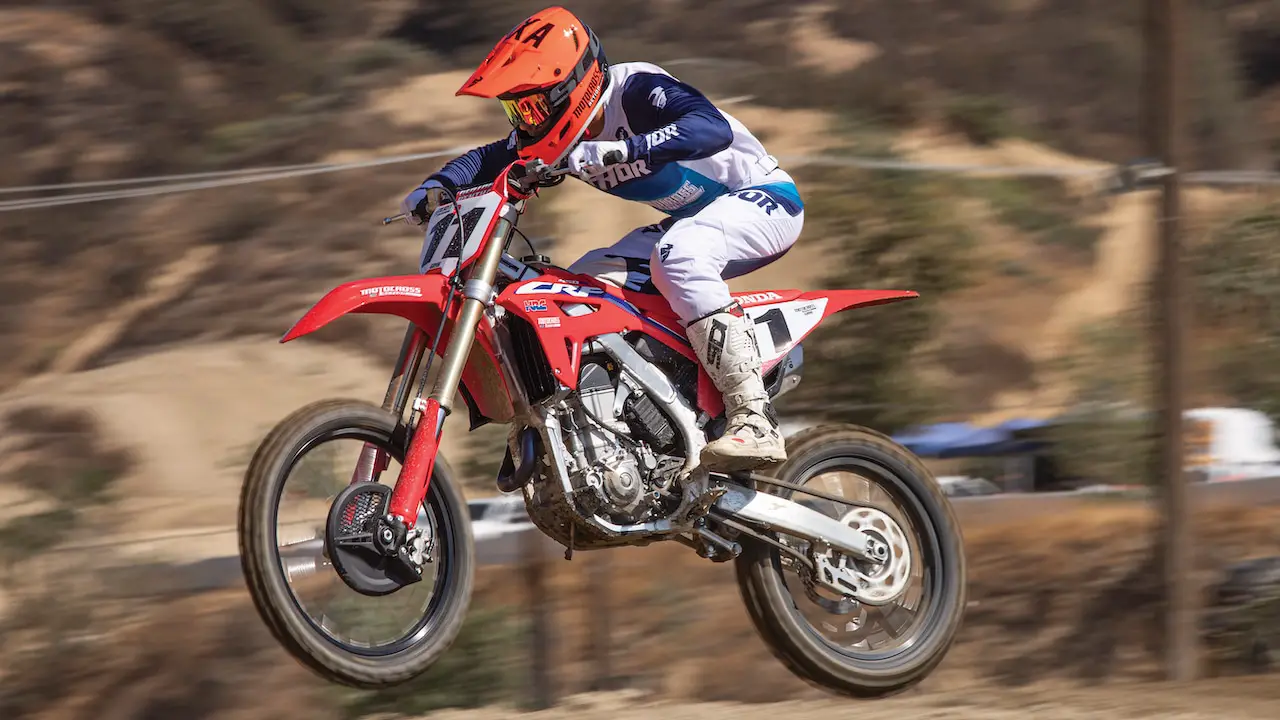

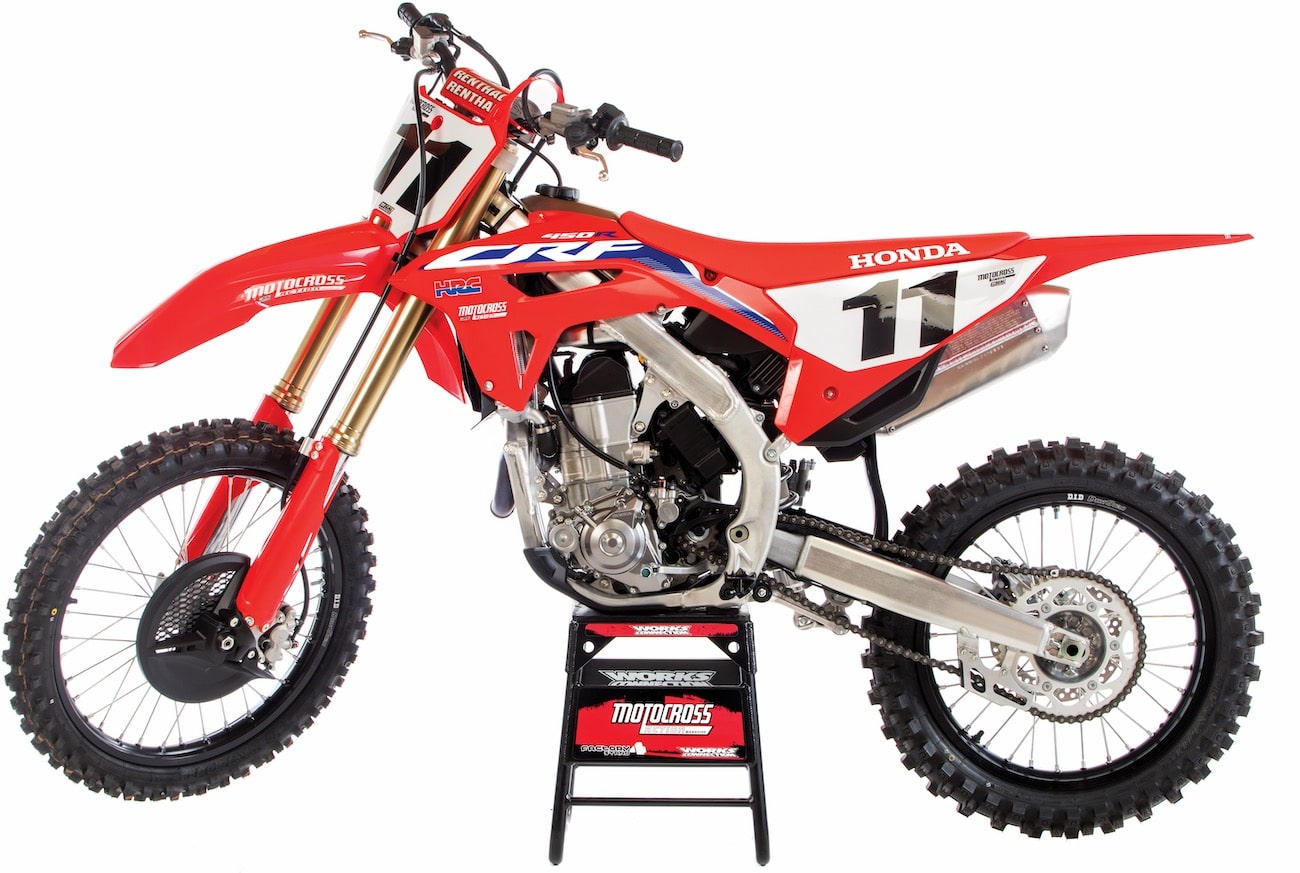



Comments are closed.